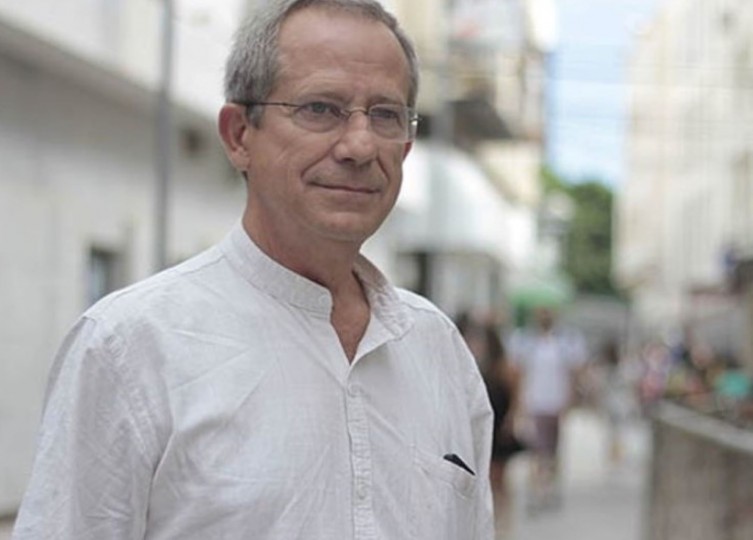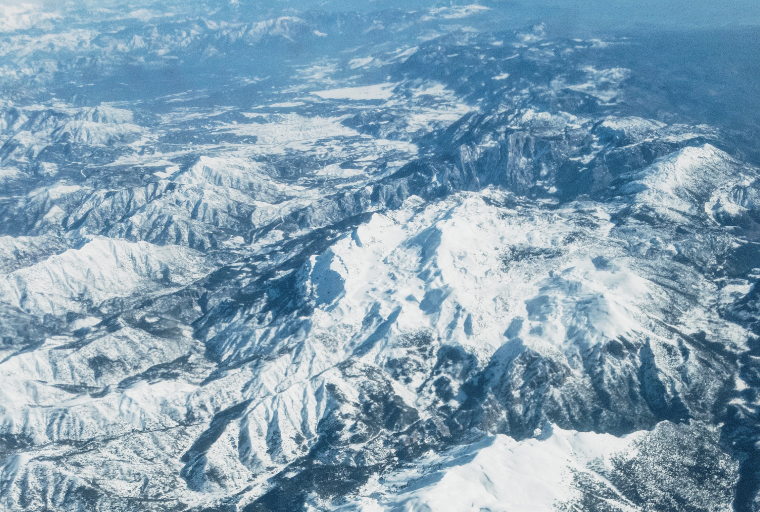 Ed. note: This article first appeared in Spanish here. This is an interview with an expert (Ferran Puig Vilar) and award-winning author of a climate blog on tipping points. Photo credit: Ferran Puig Vilar. CEDIDA POR EL ENTREVISTADO
Ed. note: This article first appeared in Spanish here. This is an interview with an expert (Ferran Puig Vilar) and award-winning author of a climate blog on tipping points. Photo credit: Ferran Puig Vilar. CEDIDA POR EL ENTREVISTADO
The straw that breaks the camel’s back. The last time the axe hits the tree before it falls. The last profitable barrel to be extracted from an oil well. There are many examples of Tipping points (TP). Although tipping points and points of no return are the buzzwords of our times, we should probably be using them more than we are.
A range of studies have long indicated that attention should be paid to the effects of climate change on subsystems such as the Amazon, Greenland ice or permafrost. These effects have been debated for more than 20 years. Since then, thousands of pages have been written describing their interrelationships, warning of a coming disaster. As in this article published in Nature by key figures in climate science, or this article published in National Geographic. However, despite the seriousness of the issue, mainstream media silence remains thunderous. We can even hear climate change deniers on prime time TV.
We ask engineer and climate journalist Ferran Puig Vilar, who is publishing a special report on tipping points, and has been doing amazing work on climate education in his prestigious, prize-winning blog for more than a decade:
What is a climate tipping point?
It is an inflection point in the equilibrium of a significant element or subsystem (permafrost, Amazon, thermohaline current, Greenland) whose overshoot destabilizes it and generates a phase change, bringing the system to a new state that may – or may not – be one of equilibrium. There are 15 specified, 9 of which are in the degradation phase or have already been passed. They interrelate with each other causing knock-on effects.
And what is the status of these TPs and how are they related?
Greenland is assumed to be melting completely. It is no longer snowing as much as it is thawing. The same is also true of Western Antarctica. These two areas alone will cause a 10-metre rise in sea levels. However, this will not be the only effect, as the resulting meltwater discharge large amounts of freshwater. Off the coast of Greenland, for example, changes to salinity, density and temperature will affect the existing currents. The thermohaline current, which is already slowing considerably, could even come to a halt, accentuating cold winters in the north. Moreover, as everything is connected, the thermohaline current also influences El Niño-Super Niño events in the Pacific, amplifying them and making them more frequent. These events are associated with droughts – and therefore mega-fires – in the Amazon. As you can imagine, this increases deforestation, bringing the Amazon itself closer to a point of no return, where it will turn into savannah. All this increases carbon emissions and the feedback loop is self-reinforcing.
And then there is the huge problem of permafrost – the ticking time bomb. Until now it has been said that its emissions were not net emissions because of the limited carbon fertilization effect so much vaunted by the fuel industry. This has now changed. There is a recent model, developed by such reputable scientists as Jørgen Randers – one of the signatories of the crucial 1972 Limits to Growth report that we now realize was so accurate. His model shows that the permafrost would melt even if emissions ceased tomorrow. In other words, it is highly likely that the tipping point will be passed.

Could we say that they are like the organs of a body, i.e. if the liver or the kidney fails, the rest of the organs will obviously suffer?
This is indeed a good comparison. They influence each other and depend on each other. And following that metaphor, we now have to stop being the pathogens that degrade those subsystems of the Earth and be more like white blood cells, the immune system. Regenerate them, as much as possible. Stop degrading and start repairing. And then hope that it is not too late to avoid the systemic cascade that would mean we have passed the point of global no return, which would take us to the Hothouse Earth anticipated by some of the best living scientists we have.
Worse than expected. You have thus defined a trend: that scientific forecasts tend to err on the side of conservatism and are usually revised for the worse. As has happened in the case of the TP, which was thought not to be compromised until it reached 5º, then 3º, then 1.5º… Why does this happen?
There are the inevitable factors, science is not only a method, it is a process, and sometimes there is so much debate that the problem is ignored until there is a more consensual conclusion. This is why the more extreme views are often not considered. Pushing scientific knowledge forward has risks; for example, if science were more daring, organised denialism would use this to further delay progress. All this contributes to other factors of self-censorship that might be more avoidable, and which also occur because certain positions, very contrary to the “logic” of the system, would not have their research funds renewed if they said things that are too catastrophic or revolutionary. It is complicated, they themselves wonder if they are failing the rest of us.
The sixth IPCC report is due in 2021, so what do you expect?
At the moment they were supposed to release it in April and they have extended it until June. They are in trouble. Successive reports have gradually worsened the forecasts, but of course, now the changes are very substantial. The difference will be bigger and therefore more difficult to justify. So far the Paris Agreement, among others, have been based on the 2013 report, so the update is important.
On the issue of biodiversity and its relationship to pandemics, is this evidence that it is not simply a problem of “emissions” but of a system that puts excessive pressure on the ecosystems that sustain it?
Yes, when we talk about “biodiversity” [it] is a euphemism for the extraordinary rate of species extinction. The invasion of natural space by the human species can have no other consequence than the invasion of some undesirable aspects – pathogens, pandemics, transmitting mosquitoes, invasive species – of the natural world into the habitats of the human species.
There are values that make you shudder when you say them: In the last 50 years according to the Living Planet Report 2020 we have liquidated no less than 68% of all vertebrate individuals in the world: mammals, birds, fish, amphibians and reptiles. A gigantic massacre in just 50 years. And this heroism of misunderstood progress could be stopped tomorrow. We have to relearn our relationship with the Earth, to get out of dualism and mechanical philosophy.
And this is evidence that neither geo-engineering nor carbon capture and sequestration projects (BEECS) are solutions. Perhaps, hopefully, for part of the problem, but the problem is broader and more cultural.
Yes, and we haven’t talked about the oceans, which also have their tipping point. They are increasingly acidified, full of micro-plastics that end up in our stomachs. We need to understand that technology, and production as we understand it, far from being the solution, is the problem. Since the Enlightenment, we have believed that more is always better, that everything is based on reason. And this is not true. Perhaps we should recover what romanticism reopened and closed at the same time, a romanticism 2.0 whose point of view is not only that of western man.
Geo-engineering, which I hope is avoided, would be the last gasp, the last arrogance: to believe that one can dominate the whole planet. It is an illusion of control. There are so many dangers, so many unwanted effects – I am thinking of solar radiation management systems – that it is better not to even try. I am not against it being studied, but the solutions do not lie this way.
As for carbon capture and sequestration, so much would have to be removed – back to between 300 and 350 parts per million of CO2 – to stabilize the climate, which at the moment is an absolute chimera, pretending to magically bury our waste is our way of sweeping the problem under the carpet. And at the moment, the Paris agreement and so on, are based on this. It makes no sense.

And then there is the energy problem. Will Steffen, one of the most eminent scientists we have, signed and promoted a manifesto saying that collapse is now the most likely outcome for our civilisation.
Yes, some of us consider that we are in that phase – maybe already in the early stages of collapse – in which problems cannot be solved as they have been solved so far, by adding complexity. If net energy does not grow, the existing complexity will decrease, whether we want it to or not. The international organizations, which are supposed to understand all this, are so tied to the current system that they have “development” in their DNA. They understand development as growth. Changing this chip is essential, but complicated.
And what would you propose?
Well, my option is to generate communities that are adapted, resilient, let’s say, in the interstices of the system, to the problem that lies ahead, while at the same time not denying the possibility of political and systemic transformation – which does not seem easy – or continuing to fight the cultural battle – for which there is no longer enough time.
Would you activate the Climate Assembly now to try to accelerate the slow process of political change?
Assemblies, not only the climate one, but also an energy one, duly advised by courageous experts, would help us to prepare ourselves better for what is to come.
Dilemma: If we scare too much, many people are blocked, and if we don’t scare enough, people don’t realize how bad our situation is. A recent study suggests that the emotions that most activate us are rage and anger.
Well, so far there has been little action, precisely because of perhaps too much lukewarmness, too much restraint. What we know is that not instilling fear does not work.
Despite all of the above, Timothy Lenton, one of the great thinkers on this subject, is now talking about positive TP, referring to the social parameters of diffusion and technological advances that can help accelerate the reaction in time to at least save as much as we can. What do you think?
Well, I think it’s like when an editor says to a writer, “hey, you have to end well”. The book can’t end badly. Everyone is free to express their opinion. It may happen, perhaps with climate assemblies, who knows. Now people are becoming more and more aware. People are no longer denying that the climate is getting much worse, if anything they are moving away, so that they can continue with the inertia, but there could be a positive turning point. Becoming aware of these issues generates a lot of painful moments, but it also generates a lot of happiness, it is deeply transformative to know that you are active, and on the right side of history.
Teaser photo by Chris Murray on Unsplash





